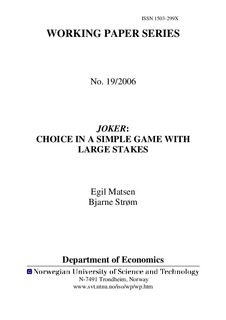| dc.contributor.author | Matsen, Egil | nb_NO |
| dc.contributor.author | Strøm, Bjarne | nb_NO |
| dc.date.accessioned | 2014-12-19T14:32:03Z | |
| dc.date.available | 2014-12-19T14:32:03Z | |
| dc.date.created | 2007-01-16 | nb_NO |
| dc.date.issued | 2006 | nb_NO |
| dc.identifier | 126251 | nb_NO |
| dc.identifier.uri | http://hdl.handle.net/11250/267209 | |
| dc.description.abstract | This paper examines data from the Norwegian television game show Joker, where contestants make well-specified choices under risk. The game involves very large stakes, randomly drawn contestants, and ample opportunities for learning. Expected utility (EU) theory gives a simple prediction of choice under weak conditions, as one choice is always first-order stochastically dominating. We document frequent, systematic and costly violations of dominance. Most alternative theories fail to add explanatory power beyond the EU benchmark, but many contestants appear to have a systematic expectation bias that can be related to Tversky and Kahneman's (1973) "availability heuristic". In addition, there seems to be a stochastic element in choice that is well captured by the so-called Fechner model. | nb_NO |
| dc.language | eng | nb_NO |
| dc.publisher | Norges teknisk-naturvitenskapelige universitet, Fakultet for samfunnsvitenskap og teknologiledelse, Institutt for samfunnsøkonomi | nb_NO |
| dc.relation.ispartofseries | Working Paper Series, 1503-299X; 2006:19 | nb_NO |
| dc.subject | Risky choice | en_GB |
| dc.subject | stochastic dominance | en_GB |
| dc.subject | choice models | en_GB |
| dc.subject | stakes | en_GB |
| dc.subject | game show. | en_GB |
| dc.title | Joker: Choice in a simple game with large stakes. | nb_NO |
| dc.type | Research report | nb_NO |
| dc.contributor.department | Norges teknisk-naturvitenskapelige universitet, Fakultet for samfunnsvitenskap og teknologiledelse, Institutt for samfunnsøkonomi | nb_NO |
